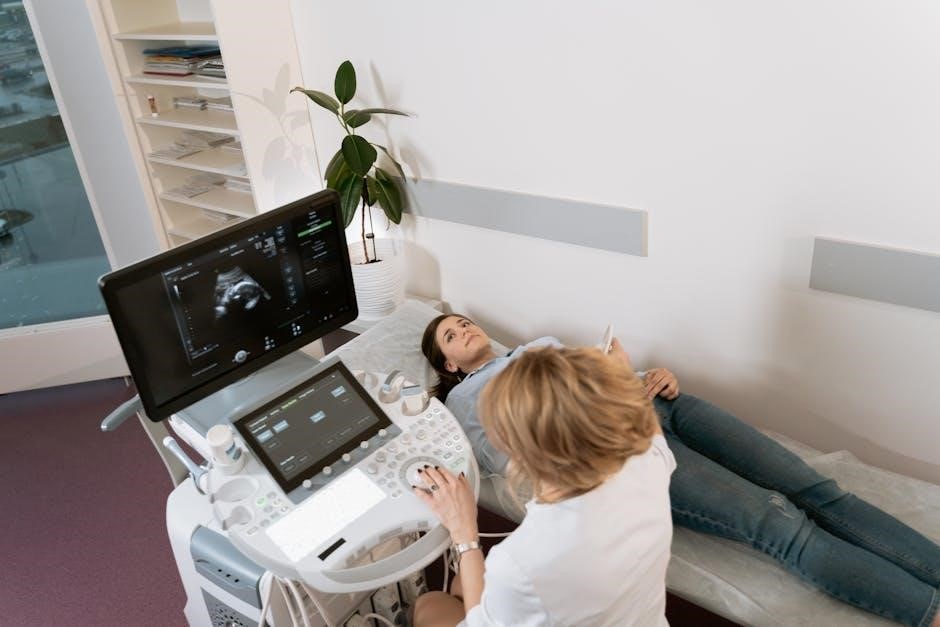EPA 609 certification is essential for technicians handling refrigerants in vehicle air conditioning systems. It ensures compliance with environmental regulations and safe refrigerant practices, requiring specialized training and testing to obtain. This certification is mandated under Section 609 of the Clean Air Act, focusing on proper refrigerant management and disposal. Technicians must pass an exam to demonstrate their understanding of EPA guidelines, with study materials like practice tests and guides available to aid preparation. Certification is crucial for professionals in the HVAC and automotive industries, ensuring they meet legal and environmental standards.
1.1 What is EPA 609 Certification?
EPA 609 Certification is a mandatory credential for technicians handling refrigerants in motor vehicle air conditioning systems. Established under Section 609 of the Clean Air Act, it ensures compliance with environmental regulations. The certification validates a technician’s ability to safely manage refrigerants, preventing harmful emissions. It is required for professionals servicing MVAC systems, ensuring they follow proper protocols for refrigerant handling, recovery, and disposal. The certification involves passing an exam that tests knowledge of EPA guidelines and safe practices, crucial for minimizing environmental impact and meeting legal standards in the automotive and HVAC industries.
1.2 Importance of EPA 609 Certification
EPA 609 Certification is crucial for ensuring environmental protection by promoting the safe handling and disposal of refrigerants. It mandates compliance with federal regulations, reducing ozone-depleting emissions and preventing environmental harm. Technicians servicing motor vehicle air conditioning systems must obtain this certification to legally work with refrigerants. The certification ensures professionals understand proper practices, minimizing risks to the environment and public health. It is an industry-recognized credential, enhancing career opportunities and demonstrating a commitment to environmental responsibility. By requiring this certification, the EPA ensures that only qualified individuals handle refrigerants, maintaining high standards of safety and compliance.
1.3 Brief History of EPA 609 Certification
The EPA 609 Certification was established under Section 609 of the Clean Air Act to regulate the handling of refrigerants in motor vehicle air conditioning systems. Created to address ozone depletion, it requires technicians to undergo training and certification to ensure safe practices. The program was introduced in the 1990s, coinciding with the phase-out of ozone-depleting refrigerants like CFCs. Over the years, the certification has evolved to include updated regulations and practices, such as the 2018 restrictions on refrigerant purchases. Its history reflects the EPA’s commitment to environmental protection and compliance in the automotive and HVAC industries.

Benefits of EPA 609 Certification
EPA 609 Certification enhances career opportunities, ensures compliance with environmental regulations, and promotes safe refrigerant handling practices, benefiting both professionals and the environment. It validates expertise, boosts credibility, and supports industry standards, making certified technicians more competitive in the HVAC and automotive sectors.
2.1 Career Advancement in HVAC Industry
EPA 609 certification significantly enhances career prospects in the HVAC industry by demonstrating expertise in refrigerant handling and compliance. Certified technicians are highly sought after by employers, as the certification ensures they meet federal regulations and can work safely with refrigerants. It opens doors to advanced roles and specialized positions, such as refrigerant recovery specialists or senior HVAC technicians. Additionally, having this certification often becomes a prerequisite for promotions and higher-paying jobs, making it a valuable asset for career growth and professional development in the HVAC sector.
2.2 Compliance with Environmental Regulations
EPA 609 certification ensures technicians comply with federal environmental regulations, particularly the Clean Air Act. It mandates proper handling, storage, and disposal of refrigerants to prevent ozone depletion and environmental harm. Certified professionals understand legal requirements for refrigerant recovery and recycling, ensuring they operate within regulatory standards. This certification is essential for businesses to avoid legal penalties and maintain environmental compliance. By obtaining EPA 609 certification, technicians demonstrate their commitment to eco-friendly practices and adherence to government guidelines, safeguarding both the environment and their professional reputation.
2.3 Enhanced Knowledge of Refrigerant Handling
EPA 609 certification enhances technicians’ understanding of safe and proper refrigerant handling practices. It equips them with the knowledge to manage refrigerants responsibly, minimizing environmental impact. The certification covers techniques for recovery, recycling, and proper disposal of refrigerants, ensuring compliance with environmental standards. Technicians gain insights into the correct use of equipment and procedures to prevent refrigerant leaks and contamination. This expertise is crucial for maintaining system efficiency and reducing emissions. By mastering refrigerant handling, certified professionals contribute to sustainable practices and uphold industry standards, ensuring their work aligns with both legal and environmental expectations.

EPA 609 Certification Exam Format
The EPA 609 exam is an open-book test with no time limit. Candidates can use the study manual to find answers but cannot receive external assistance during the exam.
3.1 Types of Questions on the Exam
The EPA 609 certification exam includes multiple-choice questions and scenario-based problems. These questions focus on safe refrigerant handling, environmental regulations, and proper service procedures for MVAC systems. Candidates are tested on their understanding of recovery, recycling, and recharging processes, as well as compliance with EPA guidelines. Practical scenarios are designed to assess real-world application of knowledge. The exam also covers safety protocols and emergency response procedures. Practice tests available online mirror the exam format, helping candidates familiarize themselves with the question types and content areas. Understanding these question types is crucial for effective preparation and success on the exam.
3.2 Time Limit and Exam Structure
The EPA 609 certification exam does not have a strict time limit, allowing candidates to complete it at their own pace. The exam is divided into sections, each focusing on specific topics such as refrigerant safety, environmental regulations, and proper service procedures. The structure includes multiple-choice questions and scenario-based problems, ensuring a comprehensive assessment of knowledge. Candidates are permitted to use the official study manual during the exam, but no external assistance is allowed. The open-book format helps ensure that technicians can apply their knowledge effectively in real-world situations. Understanding the exam structure is key to efficient preparation and successful completion.
3.3 Open-Book Policy and Allowed Resources
The EPA 609 exam follows an open-book policy, permitting candidates to use the official EPA 609 study guide during the test. This resource contains detailed information on refrigerant handling, safety protocols, and regulatory compliance. Additional resources like practice tests and webinars can aid in preparation but are not allowed during the exam. Candidates must rely solely on the provided study guide for assistance, ensuring they understand and can apply the material effectively. This policy emphasizes practical knowledge application, aligning with real-world scenarios technicians may encounter. Proper use of allowed resources is crucial for success in the certification process.

Study Materials for EPA 609 Certification
The official EPA 609 study guide is the primary resource for exam preparation. It covers key concepts and regulations. Additional materials include practice tests and webinars.
4.1 Official EPA 609 Study Guide
The official EPA 609 study guide is a comprehensive resource for exam preparation. It provides detailed information on regulations, refrigerant handling, and safety protocols. The guide is structured to cover all sections of the certification exam, ensuring candidates understand key concepts. It includes practical examples and diagrams to aid understanding. Using the official study guide is highly recommended, as it aligns directly with the exam content. Candidates can use this guide during the open-book exam, making it an essential tool for success. Regularly reviewing the guide helps reinforce knowledge and ensures compliance with EPA standards.
4.2 Practice Tests and Sample Questions
Practice tests and sample questions are invaluable tools for preparing for the EPA 609 certification exam. They provide hands-on experience with the exam format and help identify areas needing improvement. Many resources, including official EPA guides and online platforms, offer practice tests with answers. These tests cover key topics such as refrigerant handling, safety protocols, and regulatory compliance. Candidates can use these materials to assess their knowledge and refine their test-taking strategies. Regularly completing practice tests improves confidence and ensures a thorough understanding of the exam content. They are an essential part of a well-rounded study plan for EPA 609 certification.
4.3 Webinars and Online Courses
Webinars and online courses are excellent resources for preparing for the EPA 609 certification exam. These programs provide interactive learning experiences, covering key topics such as refrigerant handling, safety protocols, and environmental regulations. Many webinars are conducted by industry experts, offering insights and tips for understanding complex concepts. Online courses often include video tutorials, interactive quizzes, and downloadable materials to enhance learning. Platforms like ML Wehmeyer offer webinar dates and study guides to help candidates stay on track. These resources are particularly useful for self-paced learners, allowing them to study conveniently and effectively. They complement traditional study materials and practice tests, ensuring comprehensive preparation for the exam.
4.4 Additional Resources for Preparation
Beyond official study guides and webinars, additional resources like forums, YouTube tutorials, and mobile apps can aid EPA 609 preparation. Platforms such as Docsity offer downloadable PDFs with practice questions and answers, providing hands-on exam experience. Online forums allow technicians to share tips and discuss challenging topics. Apps like SkillCat offer interactive exercises and flashcards for on-the-go learning. Additionally, manufacturers like ESCO provide practice exams that simulate real test conditions. These diverse resources cater to different learning styles, ensuring comprehensive preparation and a deeper understanding of refrigerant handling and environmental compliance.

Preparing for the EPA 609 Exam
Effective preparation involves creating a study schedule, utilizing practice tests, and focusing on key concepts like refrigerant handling and safety protocols. Regular review and understanding of the EPA 609 study guide ensures readiness for the exam.
5.1 Study Tips and Strategies
Mastering the EPA 609 exam requires a structured study approach. Begin by thoroughly reviewing the EPA 609 Study Guide, focusing on key areas like refrigerant safety and environmental regulations. Utilize practice tests to identify weak points and reinforce understanding. Create flashcards for complex terms and concepts. Dedicate time daily to review material, ensuring consistent progress. Additionally, enroll in webinars or online courses for comprehensive instruction. Prioritize understanding rather than memorization, and simulate exam conditions during practice to build confidence and time management skills.
5.2 Understanding Key Concepts
Grasping key concepts is vital for success in the EPA 609 exam. Focus on understanding safe refrigerant handling, environmental regulations, and proper disposal methods. Familiarize yourself with refrigerant types, recovery procedures, and leak detection techniques. Study the Clean Air Act Section 609 requirements and the importance of minimizing refrigerant emissions; Review diagrams and procedures for servicing MVAC systems. Understanding these fundamentals ensures compliance and proficiency in real-world scenarios, making it easier to apply knowledge during the exam and in professional settings.
5.3 Importance of Practice Tests
Practice tests are a cornerstone of effective preparation for the EPA 609 certification exam. They provide hands-on experience with the exam format, helping candidates familiarize themselves with question types and time management. By identifying weak areas, practice tests enable targeted study and improvement. Regularly taking practice tests builds confidence and reduces exam-day anxiety. They also offer feedback on incorrect answers, reinforcing learning and ensuring a deeper understanding of key concepts. Utilizing practice tests is a proven strategy to enhance readiness and achieve success on the actual exam.
5.4 Exam Day Preparation and Tips
On exam day, ensure all materials, including your study guide and identification, are ready the night before. Arrive early to familiarize yourself with the location and reduce stress. Dress comfortably and stay hydrated to maintain focus. Review the allowed resources briefly before starting, as the exam is open-book. Allocate time wisely, answering easier questions first and returning to challenging ones later. Read each question carefully to avoid misunderstandings. Stay calm and methodical, ensuring you complete all sections. If time permits, review your answers to catch any errors. Proper preparation and composure are key to success.

After Passing the EPA 609 Exam
After passing the EPA 609 exam, you demonstrate compliance with environmental regulations and safe refrigerant handling. This certification enhances your credibility and career prospects in HVAC and automotive industries. Proper documentation and adherence to guidelines ensure ongoing compliance and professional growth.
6.1 Certification Renewal Requirements
EPA 609 certification requires renewal to maintain compliance and professional standards. Technicians must complete continuing education courses or exams to stay updated on regulations. Renewal periods vary, typically every 2-5 years, depending on the certifying organization. Proper documentation and adherence to EPA guidelines ensure ongoing certification validity. Renewal demonstrates commitment to environmental compliance and professional growth, keeping technicians informed on safe refrigerant handling and disposal practices. It is essential to check with the certifying body for specific renewal criteria to avoid lapses in certification.
6.2 Continuing Education and Updates
Continuing education is crucial for EPA 609-certified technicians to stay updated on regulatory changes and advancements in refrigerant handling. The EPA mandates ongoing training to ensure compliance with environmental standards and safety protocols. Technicians must participate in approved programs or workshops to refresh their knowledge on proper refrigerant management and disposal methods. Additionally, staying informed about updates to the Clean Air Act and new technologies is essential for maintaining certification and professional competence. Regular updates ensure technicians remain proficient in handling refrigerants safely and sustainably, aligning with industry best practices and legal requirements.
6.3 Maintaining Certification Compliance
Maintaining EPA 609 certification compliance involves adhering to renewal requirements and staying updated on environmental regulations. Technicians must ensure their certification remains valid by completing continuing education and periodic recertification. Compliance also requires proper documentation of training and adherence to EPA guidelines when handling refrigerants. Regular audits and inspections by regulatory bodies may occur to verify adherence to standards. Technicians must also stay informed about changes in refrigerant management practices and legal requirements to avoid non-compliance penalties. Ongoing commitment to compliance ensures both professional integrity and environmental protection, maintaining trust and credibility in the industry.

Handling Refrigerants Safely and Compliantly
Proper refrigerant handling ensures safety and compliance with EPA regulations. Technicians must follow guidelines for storage, disposal, and emergency procedures to minimize environmental impact and risks.
7.1 Safe Handling of Refrigerants
Safe handling of refrigerants is critical to prevent environmental harm and ensure technician safety. Proper use of EPA-certified equipment, wearing protective gear, and following venting protocols are essential. Technicians must avoid direct contact with refrigerants, as they can cause health risks. Regular inspection of equipment and proper charging procedures minimize leaks. Understanding recovery, recycling, and recharging processes ensures compliance with EPA standards. Incorrect handling can lead to fines and environmental damage, making adherence to best practices vital for both professionals and the environment.
7.2 Proper Storage and Disposal Methods
Proper storage and disposal of refrigerants are crucial to maintain environmental safety and comply with EPA regulations. Refrigerants must be stored in well-ventilated areas, away from heat sources, and in containers approved for their type. Labels must clearly indicate the refrigerant type and safety precautions. Disposal requires adherence to EPA guidelines, ensuring refrigerants are not vented into the atmosphere. Recycling or reclaiming refrigerants is encouraged, and disposal should only be done through EPA-approved facilities. Improper disposal can lead to environmental harm and legal consequences, making correct practices essential for technicians handling refrigerants.
7.3 Emergency Procedures and Spill Response
In case of a refrigerant spill or leak, immediate action is required to minimize environmental impact. Evacuate the area, wear personal protective equipment (PPE), and ventilate the space to prevent vapor accumulation. Contain the spill using absorbent materials and neutralize it with appropriate chemicals. Document the incident and report it to authorities if required. Proper cleanup ensures compliance with EPA regulations and prevents penalties. Training in emergency procedures is essential for certified technicians to handle such situations effectively and safely, protecting both the environment and public health.

Role of EPA-Approved Certification Programs
EPA-approved certification programs provide standardized training and ensure technicians meet federal regulations for handling refrigerants. They offer structured materials like practice tests and guides, aiding exam preparation and compliance with environmental standards.
8.1 Types of EPA-Approved Programs
EPA-approved certification programs for Section 609 are designed to ensure technicians meet federal standards for handling refrigerants. These programs include in-person training, online courses, and self-study materials. They cover essential topics like refrigerant safety, environmental regulations, and proper handling techniques. Many programs offer practice tests and study guides to help prepare for the certification exam. Some programs also provide webinars and interactive learning tools to enhance understanding. These programs are tailored to different learning preferences, ensuring technicians can gain the knowledge and skills needed to comply with EPA regulations effectively.
8.2 How to Choose the Right Program
Choosing the right EPA-approved program involves considering factors like accreditation, course content, and study materials. Ensure the program is EPA-certified and covers Section 609 requirements. Look for comprehensive study guides, practice tests, and interactive tools to enhance learning. Consider the learning format—online, in-person, or self-paced—to suit your needs. Check for experienced instructors and access to resources like webinars or forums. Reading reviews from certified technicians can also help identify reputable programs. Ensure the program aligns with your career goals and provides updates on regulatory changes. A well-structured program will equip you with the knowledge and skills needed for certification and compliance.
8.3 Importance of Program Accreditation
Accreditation ensures that EPA 609 certification programs meet rigorous standards, providing high-quality training and accurate information. It verifies that the program covers essential topics like refrigerant handling, safety protocols, and environmental compliance. Accredited programs are regularly reviewed and updated to reflect current regulations, ensuring technicians receive relevant and reliable instruction. Choosing an accredited program guarantees that the training aligns with EPA requirements, enhancing the credibility of the certification. This also ensures that technicians are well-prepared to handle refrigerants safely and legally, maintaining environmental and industry standards. Accreditation is a critical factor in selecting a trustworthy certification program.

Common Challenges and Solutions
Common challenges include understanding complex concepts and managing exam time effectively. Solutions involve utilizing practice tests, thoroughly studying the EPA manual, and staying updated with regulatory changes through webinars.
9.1 Overcoming Difficulty in Understanding Concepts
Understanding EPA 609 concepts can be challenging, especially for newcomers. To overcome this, break down complex topics into simpler parts and use visual aids like diagrams. Focus on key areas such as refrigerant handling, safety protocols, and environmental regulations. Referencing the official EPA study guide and practice tests can help clarify difficult sections. Additionally, participating in webinars or online courses provides structured learning and expert insights. Regular review and practical application of knowledge enhance comprehension and retention, ensuring mastery of the material for the certification exam.
9.2 Managing Time Effectively During the Exam
Managing time effectively during the EPA 609 certification exam is crucial for success. Start by skimming through the entire exam to identify easier questions and allocate time accordingly. Allocate a specific duration to each question to avoid spending too long on one. Use practice tests to build speed and accuracy, helping you gauge your pace. Prioritize answering questions you’re confident about first, then return to more challenging ones. Ensure you review your answers before submitting, but avoid overthinking. Effective time management reduces stress and allows you to complete the exam confidently within the allotted period.
9.3 Staying Updated with Regulatory Changes
Staying updated with regulatory changes is vital for maintaining EPA 609 certification compliance. The EPA frequently updates guidelines, so technicians must remain informed. Regularly check the EPA website and subscribe to newsletters for the latest updates. Attend industry webinars and workshops focusing on refrigerant handling and environmental regulations. Review updated study materials, such as the EPA 609 certification practice test and answers PDF, to ensure familiarity with new requirements. Certification programs often provide resources on recent changes, helping technicians adapt and comply with evolving standards. Continuous learning ensures adherence to regulations and enhances professional competence in handling refrigerants responsibly.

Impact of EPA 609 Certification on the Industry
EPA 609 certification has elevated industry standards, ensuring environmentally responsible practices. It fosters professionalism among technicians, promotes compliance, and supports eco-friendly refrigerant handling, benefiting both businesses and the environment.
10.1 Increased Professionalism in HVAC Technicians
EPA 609 certification has significantly elevated the professionalism of HVAC technicians by ensuring they meet standardized knowledge and skill requirements. This certification demonstrates a technician’s commitment to environmental compliance and safe refrigerant handling. By requiring a thorough understanding of EPA regulations, it enhances the quality of service provided in the industry. Certified technicians are better equipped to handle complex tasks, which boosts customer confidence and industry credibility; This professionalism fosters trust and reliability, making certified technicians more valuable to employers and clients alike in the HVAC sector.
10.2 Environmental Benefits of Proper Certification
EPA 609 certification plays a vital role in minimizing environmental impact by ensuring proper refrigerant handling and disposal. Certified technicians are trained to reduce refrigerant emissions, protecting the ozone layer and mitigating climate change. The certification emphasizes safe recovery, recycling, and disposal practices, preventing harmful refrigerants from releasing into the atmosphere. By adhering to EPA guidelines, certified professionals contribute to a significant reduction in environmental damage. This aligns with global efforts to combat ozone depletion and greenhouse gas emissions, highlighting the importance of certification in promoting eco-friendly practices within the HVAC industry.
10.3 Market Demand for Certified Technicians
Market demand for EPA 609-certified technicians is increasing due to growing environmental regulations and the need for skilled professionals in HVAC and automotive industries. Employers prioritize certified individuals, as they ensure compliance with EPA standards and demonstrate expertise in refrigerant handling. The certification enhances job prospects, making technicians more competitive in the market. As industries focus on sustainability and eco-friendly practices, the demand for certified professionals continues to rise. This certification is a key factor in career advancement and higher earning potential, making it a valuable asset for technicians aiming to succeed in their field.
Obtaining EPA 609 certification is a vital step for HVAC professionals, ensuring compliance and expertise in refrigerant handling. Utilize practice tests and study guides to prepare effectively. Stay updated on regulatory changes and maintain certification through continuous learning. Encourage aspiring technicians to pursue this certification to enhance their career prospects and contribute to environmental sustainability. Take the next step confidently and invest in your professional growth with EPA 609 certification.
11.1 Summary of Key Takeaways
EPA 609 certification is crucial for professionals handling refrigerants in vehicle air conditioning systems. It ensures compliance with environmental regulations and safe practices. Technicians must pass an exam demonstrating knowledge of EPA guidelines. Study materials, including practice tests and guides, are essential for preparation. Certification is mandated under the Clean Air Act, focusing on proper refrigerant management and disposal. It enhances career prospects, ensures legal compliance, and promotes environmental sustainability. Utilizing resources like practice exams and webinars aids in successful certification. Staying updated on regulatory changes is vital for maintaining certification and professional growth.
11.2 Encouragement for Aspiring Certificants
Pursuing EPA 609 certification is a valuable step for aspiring technicians. It opens doors to career advancement and ensures compliance with environmental standards. With dedication and proper preparation, achieving certification is attainable. Utilize study guides, practice tests, and online resources to build confidence. Understanding key concepts and staying focused during the exam will lead to success. Remember, certification not only enhances your skills but also contributes to environmental conservation. Stay motivated, leverage available tools, and aim for excellence in your HVAC or automotive career. Your efforts will pay off, leading to professional growth and industry recognition.
11.3 Final Tips for Succeeding in the Exam
Thoroughly review the EPA 609 study guide and practice tests to familiarize yourself with the exam format. Focus on understanding key concepts, such as refrigerant handling and safety protocols. Time management is crucial; allocate your time wisely during the exam. Take advantage of the open-book policy by using the provided resources effectively. Stay calm and read each question carefully to ensure accurate answers. Practice under timed conditions to build confidence. Lastly, ensure you understand the environmental regulations and their practical applications. With dedication and proper preparation, you’ll be well-equipped to succeed and achieve your EPA 609 certification.
